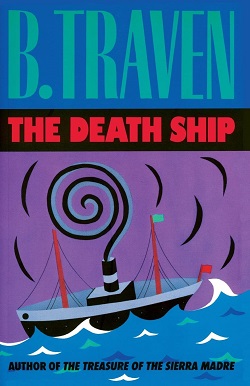By Stuart Mitchner
I was willingly drawn into the whole scene, like a random character in a B. Traven novel.
—Patti Smith, from M Train
 Mexico’s Mysterious Stranger” is the way James Agee characterized B. Traven in his February 2, 1948 Time review of John Huston’s film adaptation of The Treasure of the Sierra Madre. I’ve been haunted by Traven’s multi-faceted invisibility ever since last week’s column on the “disappearing poet” Weldon Kees, who told a friend in his last phone call in May 1955: “I may go to Mexico. To stay.” My interest in Traven began in earnest on Albert Einstein’s birthday, March 14, Pi Day in Princeton, after hearing that Traven’s The Death Ship (Das Totenschiff), published in German in 1926, is the novel Einstein named when asked what book he’d take to a desert island.
Mexico’s Mysterious Stranger” is the way James Agee characterized B. Traven in his February 2, 1948 Time review of John Huston’s film adaptation of The Treasure of the Sierra Madre. I’ve been haunted by Traven’s multi-faceted invisibility ever since last week’s column on the “disappearing poet” Weldon Kees, who told a friend in his last phone call in May 1955: “I may go to Mexico. To stay.” My interest in Traven began in earnest on Albert Einstein’s birthday, March 14, Pi Day in Princeton, after hearing that Traven’s The Death Ship (Das Totenschiff), published in German in 1926, is the novel Einstein named when asked what book he’d take to a desert island.
The “American” Sailor
Apparently born in Germany in February 1882, the man who claims never to have laid eyes on his birth certificate died in Mexico City on March 26, 1969, a coincidence it’s hard to ignore on March 26, 2025 — which is why I’m reading Einstein’s desert island novel, subtitled The Story of An American Sailor. The fact that Traven himself translated the book into English helps explain certain peculiarities in the easygoing conversational narrative by a German castaway passing himself off as an American while casually referring to Cincinnati as a city in Wisconsin. Left behind by an American ship, without papers or passport, the sailor is shunted by various immigration authorities from Belgium to Holland to France to Spain, where he boards a massively devastated ship called the Yorikke, no doubt after the “fellow of infinite jest” whose skull Hamlet muses over prior to the “death ship” of Shakespeare’s ending. more










 Mexico’s Mysterious Stranger” is the way James Agee characterized B. Traven in his February 2, 1948 Time review of John Huston’s film adaptation of The Treasure of the Sierra Madre. I’ve been haunted by Traven’s multi-faceted invisibility ever since last week’s column on the “disappearing poet” Weldon Kees, who told a friend in his last phone call in May 1955: “I may go to Mexico. To stay.” My interest in Traven began in earnest on Albert Einstein’s birthday, March 14, Pi Day in Princeton, after hearing that Traven’s The Death Ship (Das Totenschiff), published in German in 1926, is the novel Einstein named when asked what book he’d take to a desert island.
Mexico’s Mysterious Stranger” is the way James Agee characterized B. Traven in his February 2, 1948 Time review of John Huston’s film adaptation of The Treasure of the Sierra Madre. I’ve been haunted by Traven’s multi-faceted invisibility ever since last week’s column on the “disappearing poet” Weldon Kees, who told a friend in his last phone call in May 1955: “I may go to Mexico. To stay.” My interest in Traven began in earnest on Albert Einstein’s birthday, March 14, Pi Day in Princeton, after hearing that Traven’s The Death Ship (Das Totenschiff), published in German in 1926, is the novel Einstein named when asked what book he’d take to a desert island.






